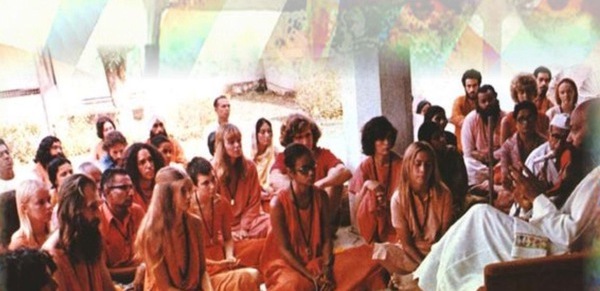Talk:Sannyas: Orange and Mala
Editing Discussion
A great idea, great pics, brilliant quote from Osho, and the extract from "Sam", well, it's pretty good in its way and definitely should have a place, but it may not be representative, ie "objective" or inclusive enough to be featured on the article page.
In fact, Osho's quote suggests strongly that this Talk page should be the place for it, along with other (sub-)articles on the theme. Sam has a viewpoint, nothing wrong with that, and he's a good writer, and he does his best to be far-seeing, eclectic and so on, but his words are still just a view, even as it purports to be a large view, perhaps as seen from far above.
In just one example of where he misses the really large view (thus marginalizing his whole presentation), he writes:
- "Psychotherapy, meditation, creativity, mysticism...it’s a huge synthesis. And a synthesis existing not just as theory but as a quasi-political, international movement, with people at very different stages of their own individual development.
- "What can hold it all together?
- "I spent ages trying to think my way through this, while all along the answer was under my nose."
And what can this answer be that was right under his nose? Orange and the mala. Fine as far as it goes, but really in an important way, he has missed the answer to his rhetorical question, because it's surely Osho (in our hearts) that holds it together. Perhaps his problem was that he was thinking his way through it. Or perhaps he is writing only about outer symbols, but then those symbols cannot be said to be holding anything together, they are at most a device of recognition and bonding etc.
Blah blah whatever. Let's get some more writing on "Sannyas: Orange and Mala" and put it here, and have something else on the article page. Could be more Osho quotes, or more fact-based words less tilting to a view, or just that one quote and the pics, and an invitation ... -- doofus-9 (talk) 17:49, 15 February 2015 (UTC)
yes, point taken. let's stick to facts as far as they can be extracted for such a subjective topic as Sannyas. i left Sam's quote here below since it reads so well.
i stayed away from more Osho quotes, a) because there are hundreds, and b) he of course contradicts himself to become unquotable. don't you love him?
so now we have a big empty page... any suggestions anyone? --Rudra (talk) 09:50, 16 February 2015 (UTC)
There's nothing wrong with this big empty page, in fact it's great, the pics are great, and the colour chart a great addition. What might be added: some facts and words, and an invitation to add other "rationalizations".
But this page ... seeing Sam's writing here made me wonder, if our discussions and chit-chat might clutter it. Maybe it (and its future companions) might be better on a separate page, an "About Sannyas: Orange and the Mala" page. OR we can delete our discussions once they've reached a conclusion or have a small area for discussions. A comparable situation might be the Talk:Osho Books on CD-ROM page, which has a lot of info and no clutter/chat.
This kind of page, ie "About Sannyas: Orange and the Mala", might become somewhat common eventually, so the separate page model might be the best way to go. Then they could have their own talk pages as well. -- doofus-9 (talk) 08:24, 17 February 2015 (UTC)
firstly, we shouldn't really delete these discussions. they make the wiki more human and less factual, they give the wiki a nice balance.
secondly, introducing another "About" page-level doesn't work in my opinion, but we could introduce a new category of "Book Excerpts & Quotes" which may eventually grow to have striking excerpts of all first edition Osho books and some sannyasin books.
now, to the facts: do anyone know when the round wooden malas and when the plastic malas were introduced?
and who designed them? was it Osho alone or was it a collaboration of sort?
and in Buddhism the 108 beads represent 108 (i guess) common sins. but Osho said they represent 108 meditations. Huhhh? 108 ? which 108? the Book of Secrets contains 112. so can't be them.
--Rudra (talk) 10:43, 17 February 2015 (UTC)
Re 108, it's a far wider tradition than just Buddhism. This page and others give some sources and speculation. I like the Sun-Earth / Earth-Moon ones, give a nice cosmic reason. Basically it seems fairly universal in India, another outward form Osho adopted like, well, orange and the mala.
Re ' "About" page-level', i wasn't proposing a new namespace or even anything formal or necessarily organized, just saying pages about sannyas and its history will appear more and more (i assume) and commentaries and rationalizations about orange and the mala could be one of them. Sam could get buried here. -- doofus-9 (talk) 19:01, 17 February 2015 (UTC)
Essays on the Theme
What was that orange and mala thing all about? Your pithy words could be here, long or short.
The Colour of Magic
(Extract from Sam's book, Life of Osho, p 255-259)
Psychotherapy, meditation, creativity, mysticism...it’s a huge synthesis. And a synthesis existing not just as theory but as a quasi-political, international movement, with people at very different stages of their own individual development.
What can hold it all together?
I spent ages trying to think my way through this, while all along the answer was under my nose.
Really, it couldn’t have been more obvious. For what was the bottom line of sannyas? What happened when you ‘took sannyas’ in the old days? The basic thing? The most obvious thing? You wore orange...You adopted the centuries- old colour of the spiritual misfit in India. You dressed like a sadhu. In fact that was all there was to taking sannyas, that and the mala: the rest was optional, the lecture, the meditations, the groups. At darshan I remember Osho telling people, O.K., go down to Goa;- hang out on the beach, get stoned if you must, nothing wrong with it...nothing wrang with it, rolling his eyes horribly...just wear the orange.
In fact the orange was the only thing about which Osho put his foot down.
Dharm Jyoti illustrates the point vividly in her memoir of Osho in his Bombay days. At the time Osho first introduced the idea of wearing orange she and several of her friends did everything they could to avoid doing any such thing. Having put off getting an orange dress from one day to the next, finally she went round to see Osho in his flat. He was sitting in his room, waiting for her with a large bolt of orange cloth he had just bought in the bazaar. Producing a pair of tailor’s scissors, he invited her to cut the cloth for her robe there and then.102 You can’t get much more hands-on than that.
Not that Dharm Jyoti was alone in her resistance to the idea. In fact it was precisely the orange, that and the mala, which most got up people’s noses about sannyas. Wearing orange seemed the very hallmark of a cult: as though people were almost gratuitously flaunting their servility: their desperate need to belong.
Perhaps at the time a lot of people who took sannyas in the West weren’t aware of the associations of that particular colour in India. In Indian society, orange clothes signalled, and signalled without the slightest ambiguity, one thing and one thing alone: drop-out.
Culturally this went back thousands of years. Traditional Hindu society had assigned orange to the criminal outcaste; and even in the late twentieth century orange robes – orange rags and tatters more like – were still the hallmark of the sadhu;- and it was the life-style of the sadhus, rather than any particular aspect of Buddhism or Hinduism which was the orginal Hippie turn-on to Eastern spirituality. It was the sadhus who brought a whole new dimension to the idea of ‘dropping out’ and being ‘on the road;’ they showed that at least one version of the alternative society could work. And there were extraordinary numbers of them: even when I was first in India figures of fifteen to twenty million throughout the sub-continent were still being bandied about.
Sadhus were a sort of anarchists’ union. All varieties of God-obsession – fakirs, bhaktis, gnani yogis – jostled with downright rogues, potheads and madmen. Some were genuine saints and visionaries, others sort of Boy Scouts noir. Some were based in a particular ashram, others seemed to be permanently on the road, either wandering along the old pilgrimage trails in the Himalayas, sleeping under the stars, or hitching incredible distances across the plains to temples deep in the South. In its way, it was a life of pure celebration. No one owned anything, just a pot or a blanket maybe, but they lived and meditated, without needing to work, in some of the most dramatically beautiful country in the world...
Admittedly, the first thing wearing orange in the West brought about was a sense of group cohesion. But what’s wrong with that? At this point, anyone can see the central psychological feature of this society is that it is isolating everyone – isolating each one of us, and robbing us of our power – and it was just this process that wearing orange threw into reverse. Like-minded people began to stand up in public and be prepared to be counted: suddenly you were meeting more people than you’d ever met in your life, and a whole social underground was yours for the asking. Orange provided that most basic function of culture, it brought people together.
But that was only half the story. Because at the same time as it brought people together it also set you apart. Let’s face it, the basic thing wearing orange did was...make you look a complete dickhead. Orange put you on the spot. Suddenly you had to stand up for yourself. Suddenly you had to walk your talk. “A sense of humour” Osho observed “should be the foundation stone of the future religiousness of man.” Well, the first time you wore your orange to the supermarket you found out exactly what that meant. The mayhem wearing orange caused overturned any Us/Them applecart. Far from being the most cultic thing about sannyas, it was the least cultic thing of all. What wearing orange was, was probably the most powerful, and certainly the funniest of all the meditation techniques Osho invented: it brought inside and outside together.
For the major part of his career, Osho was to insist that the energy generated by this played an irreplaceable role in sannyas. Only with the collapse of the Ranch did he give up on it;- and, in retrospect, you can see that it was from this point onwards that all the real fight was knocked out of sannyas. It lost its edge when it lost its street presence. It lost its cheek. It lost its balls. In fact it started, from precisely this point, to become a cult...secretive, hierarchic, and basically conformist.
There’s no need to be hung up about the colour orange per se, as though it were some dogma. Though I must admit I’m tempted...this could still prove the kicking-off point for a new and particularly virulent sannyas fundamentalism: the Dynamic, orange, free love...But I’d best back off, and do no more than stress the richness, the multiplicity of the functions the colour played. Perhaps there’s something else which could do the same thing today;- though personally I’d be at a loss to suggest what it could be... Other emerging cultures have had the guts to stand up and be counted in some such manner – Hippies did it with Levis, Rastas with dreadlocks – but the orange has something both more archaic and more...more child-like, more playful about it than that. That’s what the sadhus say about their bleached- out orange and apricot rags: that they are the colours of the first rays of the rising sun. That there’s a new day coming;- and these are its colours.
A Small Rationalization
(or Tale told by a Doofus)
The colour chart which came ~1980 reflected an easing of the "orangeness" of the orange. In earlier days, it was more monochrome, and bright, not much the faded orange of the sadhus. And hence, as Sam observes, more cultish in the image it projected, really making the wearer stand out. Earlier sannyasins were "encouraged" to wear what is called in English "highway worker orange", the whole purpose of which is of course to make the wearer highly visible.
Sannyasins in Berlin had a small camouflage / resonance. City maintenance, garbage and cleaning workers also wore this bright colour, with a big BSR emblazoned in black, standing for Berliner Stadtreinigung, or Berlin City Cleaning. (They still do, it seems, there's a lot of bright orange on their website, and they cry "So orange ist nur Berlin" and "Werden sie orange".) The BSR as we know really stands for Bhagwan Shree Rajneesh. -- doofus-9 (talk) 19:41, 17 February 2015 (UTC)
An interpretation of Sw Ageh Bharti about the origin of Sannyas
I would like to draw the attention of the reader to a story of Sw Ageh Bharti, where he relates what, in his interpretation, is the origin of Sannyas. --Sugit (talk) 11:17, 4 June 2016 (UTC)
Blessed Days With Osho, chapter "HE IS CROWNED WITH DANGERS"
- (...)
- At Ludhiana also, before leaving for the Railway station, while chatting He had told us that wherever He had to speak, some friends should reach there two to three days earlier and in the morning they should walk on the streets of that area chanting kirtan’. By this, the atmosphere of the city would be purified and this kind of disturbance shall not occur. But after that He did not go for public talks anywhere and cancelled His scheduled talks too.
- Although Harish and I went to Aajol meditation camp and Harish attended the camp in saffron clothes, Osho in it initiated friends in to sannyas in Manali meditation camp in September 1970. Later on two ‘kirtan mandalis ’ were sent around the country who were dancing and chanting kirtan on the roads, giving talks, playing Osho’s talks on audio cassettes and introducing Osho-meditations to people.
- P.S.
- For learning about the deafening uproar of public in the said Osho lecture on August 23, 1970 at Ludhiana, lovers can listen to audio cassette ‘NAYE SAMAJ KI KHOJ #10’.
Beloved Osho, chapter "17. The Beginning of Neo-sannyas"
- (...)
- According to me as I saw, the first thought of giving sannyas occurred to Osho on August 23,1970 at Ludhiana during one of his evening speeches. Kindly refer to the chapter titled, He was crowned with danger of my book 'Osho Gatha'. On that evening, that was the last speech of Osho delivered during that journey. He is answering the questions. Hardly had he spoken for forty-five minutes when some dim-witted started shouting and making noise. For a while peace was restored, but then as soon as Osho started speaking the hooligans began to shout again and advanced towards the stage. Some of them went up the stage also. Someone else caused disturbances by destroying the tent. Others disconnected the wire with the result that the mike stopped functioning. The meeting was greatly disturbed. Ultimately, on being told by some friends that Osho had to leave by the 11 o'clock train, he stopped in the middle of the speech and was taken to the host's residence. I had taken along with me the magazine Ukrand so I reached home 20 to 25 minutes later. I took my seat near Osho. There were dozens of friends, including Kapil, Kusum and others were sitting there too. I said, "I feel deeply pained for all that happened today during the discourse."
- To this, Osho replied, "What you are expected to do now is to reach the site of my discourses with a few friends 2 or 3 days before the scheduled program and every morning the entire group should take a round of that place singing devotional songs on the road in the early morning. By this, the atmosphere of the city will get purified to an extent and when I come to speak two or three days after this, I think there will be no such protest. No opposition."
- After this ugly incident when we reached the station, a whole mob was seen waiting there with black flags in hand. And, they were shouting ugly slogans of Murdabad. Even lovers retorted to this by shouting favorable slogans. On the very same day, Osho asked Shri Harish Chandra (now Sw Chaitanya Bharti) to come to the Ajol Meditation Camp with saffron clothes. This camp was to start after two or three days. This was told by Shri Harish Chandra himself.
- Harish Chandra got two saffron Kurtas and two lungis made and these he took with him. I too attended the Ajol Camp going there from Delhi via Ahemadabad. But in this Ajol Camp Osho did not start giving Sannyas although it had occurred to his mind earlier at Ludhiana. This - giving sannyas - he started in September-October at Manali.
- Today I wish there was someone who would successfully convey my thanks to all those opponents there for if they had not opposed.
- I am not sure whether the idea of giving sannyas would have dawned upon or not. And, even if it did, who knows when? In giving sannyas, the main role was decidedly that of Osho but today it seems that even those rogues had cooperated in this move.
- For, without their opposition, perhaps it would not have been possible.




